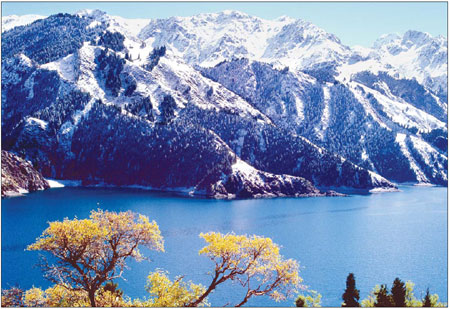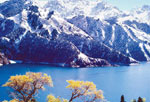The final frontier
Updated: 2011-04-29 10:26
By Xiao Xiangyi (China Daily European Weekly)
Xinjiang is a mysterious land of extremes that never falls to fascinate
Wandering around the ruins of the long lost ancient city of Loulan is a surreal experience. Loulan is known as the "Pompeii of the desert? because it, too, was once a beautiful city, but suffered a natural disaster that transformed it into a desert wasteland. Its mystery and buried glories of the past continues to draw an incessant stream of tourists who are discovering Xinjiang Uygur autonomous region, in China's rugged northwest.
 |
|
Tianchi Lake, or Heavenly Lake, which is 100 km east of Urumqi, |
Xinjiang is different from the rest of China in every conceivable way. You see Uygur bread in the shape of extremely large pizzas, Muslim Uygur women wearing headscarves and facemasks in 60 C heat, and 3,000-year-old poplar trees, which echo back to a lost world.
When travelers of the ancient Silk Road made their way to and from China, they all had to pass through Xinjiang, which was originally known as Western Region. Today, romantic images about Central Asia still linger in the region like exotic bazaars, flowing dunes and camel caravans laden with jewelry and spice.
The autonomous region is made up of 45 percent Uygur people, who are mostly Muslim, 40 percent Han Chinese and a collection of other ethnic groups. The Uygur people have a similar appearance to Europeans with light colored eyes and curly hair.
 |
Xinjiang, which means "new territory", is the largest provincial region in China but with only 5 percent of the land inhabitable, has a relatively small population of 21.5 million people.
Its ethnically diverse community and stunning scenery of mountains, basins, rivers and deserts makes it an intriguing and magical place to visit. Here are the top five highlights:
1. Turpan city
Urumqi, the capital of Xinjiang, is your launch pad and after a quick city tour head straight to charming Turpan. This is the place to explore the ruins along the old Silk Road or one can just relax under the grape vines.
As well its distinctive mosque architecture, Turpan's bazaars and street markets are also worth inspection. Here you can buy many unique Asian products, such as special roots, fragrant herbs, and even dried animals.
Flaming Mountain is 10 km away from Turpan city and every Chinese knows its name thanks for the classical novel Journey to the West by Wu Cheng'en and its hero - the Monkey King. Grape Valley, which is not far from the Flaming Mountain, makes almost every Chinese burst out saying "grape" when they hear the name of Turpan. Because of high temperature disparity between night and day and other favorable climate and environmental conditions for agriculture, top quality grapes are produced here.
2. Tianshan Tianchi National Park
Tianchi Lake, or Heavenly Lake, which is 100 km east of Urumqi, is dubbed "the Pearl of Tianshan Mountains". With melted snow as its source, Heavenly Lake is filled with crystal water and is an amazing sight to behold.
At an elevation of 2,000 meters, the lake covers an area of 4.9 square kilometers. In summer, its cool surroundings provide an ideal escape from the blistering heat.
 |
Visitors taking boat rides on the lake can see the ever-changing silver mountains stretching into the heavens and marvel at the slopes, which are ornately decorated with verdant pasture and flamboyant wild flowers. Fishing at dusk is also a great charm. The breathtaking beauty of Tianchi is not easy to forget.
3. Ili River Valley
"You will never realize how large China is until you come to Xinjiang, and you have no idea how beautiful Xinjiang is until you see Ili," goes an old Chinese saying.
Located in the heart of central Asia, Ili River gave birth to the early civilization of the west Xinjiang area.
In summer and autumn, large lavender fields, which look like an ocean of purple waves, emit the sweetest fragrance and could be mistaken as the countryside of Provence, France. Locally produced lavender perfume is available in souvenir shops. An Ili River sunset is incredibly enchanting and a photographer's favorite.
4. Kanas Lake
Unlike the Heavenly Lake, Kanas is not chocked with tourists. Sitting at the heart of Xinjiang's Altai region, Kanas Lake's scenery rivals that of any Alpine area. Tourists bound for Switzerland may want to re-think their travel plans once they discover Xinjiang's abundance of natural beauty.
With nearly 1,000 plant species, 300 kinds of animals and 100 different types of birds, the Kanas Lake area is unique for its bio-diverse habitat.
5. Ruins of Ancient Loulan
The ruins of Ancient Loulan are perfect final leg of your trip to Xinjiang.
Not far from the Lop Nor in southeastern Xinjiang, sits Loulan, which was established as a kingdom in 176 B.C. and flourished for at least 800 years. The sudden disappearance of this once powerful civilization is still one of the great mysteries in human history. But the cultural relics of this time are there to be seen, even though they are not easily accessible.
Loulan has been long known as "the forbidden zone" for the harsh environment in desert. It is suggested that visitors to travel in groups and ride camels. Take sufficient water, warm clothes, sunglasses and eye drops.
E-paper

Head on
Chinese household care goods producers eye big cities, once stronghold of multinational players
Carving out a spot
Back onto center stage
The Chinese recipe
Specials

British Royal Wedding
Full coverage of the royal wedding of Prince William and Kate Middleton in London. Best wishes

The final frontier
Xinjiang is a mysterious land of extremes that never falls to fascinate.

Bridging the gap
Tsinghua University attracts a cohort of foreign students wanting to come to China.
